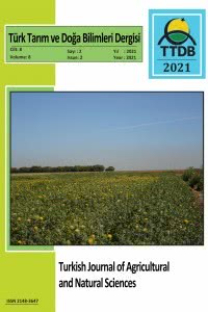Possibilities for Control of Corky Root (Pyrenochaeta lycopersici Schn., Gerl.) in Tomato Grown in Cultivation Facilities
-
Possibilities for Control of Corky Root (Pyrenochaeta lycopersici Schn., Gerl.) in Tomato Grown in Cultivation Facilities
___
- Gerlach, W. and Schneider, R. 1964. Nachweise in Pyrenochaeta stadiums bei Stammen des Korkwurzelerregers der Tomate. Phytopathol. Z. 50: 262–269.
- Giotis, Ch., Markelou, E., Theodoropoulou, A., Toufexi, E., Hodson, R., Shotton, P., Shiel, R., Cooper, J. and Leifert, C. 2009. Effect of soil amendments and biological control agents (BCAs) on soil-borne root diseases lycopersici and Verticillium alb0-atrum in organic greenhouse tomato production systems. Eur.J.Plant Pathol. 123:387- 400. Pyrenochaeta
- Golzar, H. 2009. First report of Pyrenochaeta lycopersici, causal agent of tomato corky root rot in Astralia. Aus. Pl. Dis. Not., 4, 126-128.
- Grove, G. G. and Campbell, R. N. 1987. Host range and Pyrenochaeta lycopersici. Plant Disease, 71, 806–809. in soil of
- Haine, N. M., Smith, F. G., Ebben, M. H., Last, F. T., Atkinson K. and. Lidler, J. H 1968. Techniques for minimizing yield losses, attributable to potato root eelworm and pathogenic tomatoes in unheated glasshouses. Expl. Hort. 18: 1–31. growing
- Hasna, M. K., Martensson, A., Persson P. and Ramert, B. 2007. Use of composts to manage corky root disease in organic tomato production. Annals of Applied Biology, 151: 381-390.
- Lindani, N. and Brutsch, M. O. 2012. Effects of the Integrated Microorganisms, compost and mineral fertilizer on greenhouse-grown tomato. A. J. of Pl. Sci. 6(3), 120-124 Effective
- Lindani, N., Mnkeni, P. N. S. and Brutsch, M. O. 2011. Agronomic suitability of effective micro-organisms for tomato production. A. J. of Pl. Sci. 6(3), 650-654.
- Pohronezny, K. L. and Volin, R. B. 1991. Corky Root Rot. In: Compendium of Tomato Diseases. Jones, J.B., Jones, J.P., Stall, R.E. & Phytopathological Society, Minnesota, USA. pp 12-13. American
- Pohronezny, K. L. and Volin, R. B. 1997. Corky Root Rot. In: Compendium of Tomato Diseases. Jones, J.B., Jones, J.P., Stall, R.E. & Phytopathological Society, Minnesota, USA. pp 12-13. R. Pyrenochaeta Description of Pathogenic Fungi and Bacteria, 398. American Schneider, and Gerlach, lycopersici. CMI,
- Shishkoff, N. and Campbell R. N. 1990. Survival of Pyrenochaeta lycopersici and the Influence of temperature and Cultivar Resistance on the Development of Corky Root of Tomato. Plant Disease, 74, 889– 894.
- Smith, J. W. M. and Proctor, P. 1965. Use of disease resistant root stocksfor tomato crops. Expl Hort 12: 6-20.
- Workneh, F., van Bruggen, A. H. C., Drinkwater, L.E. and Shennan, C. 1993. Variable associated Phytophthora root rot of tomatoes in organic Phytopathology, 83, 581–589. and and conventional farms.
- ISSN: 2148-3647
- Yayın Aralığı: 4
- Başlangıç: 2014
- Yayıncı: Prof. Dr. Mevlüt AKÇURA
Determination of Optimum Harvest Date of Sweet Cherry cv. Lapins Grown in Isparta
Özgür ÇALHAN, Cemile Ebru ONURSAL, Atakan GÜNEYLI, İsa EREN, İsmail DEMIRTAŞ
Filiz ÜNAL, F. Sara DOLAR, A. Faik YILDIRIM, Erkol DEMİRCİ
Mehmet Turan TOKER, Serkan OZKAYA
Cadmium and Zinc Accumulation in Maize Influenced by Zinc Fertilizer in Cadmium Polluted Soil
Bahar SOZUBEK, Korkmaz BELLITURK, M. Turgut SAGLAM
The Last Barrier for 00-type interspecific rapeseed (Brassica napus L.): Glucosinolates
Sofralık Bazı Kiraz Çeşitlerinin Fizikokimyasal Özellikleri
Effects of Harvesting Time on Nutritional Value of Hydroponic Barley Production
Hande İşıl AKBAĞ, Onur Sinan TÜRKMEN, Harun BAYTEKİN, İsmail Yaman YURTMAN
Mehmet AKSU, Hasan Cumhur SARISU, İsmail DEMİRTAŞ, İbrahim GÜR, Hakkı KOÇAL, Atakan GÜNEYLİ
